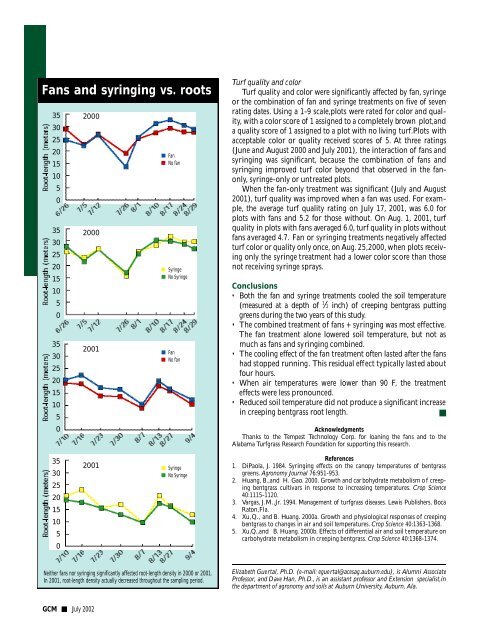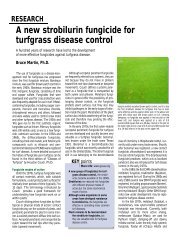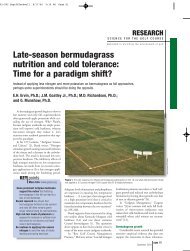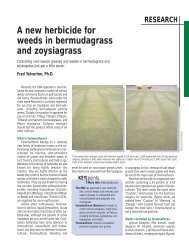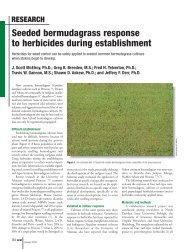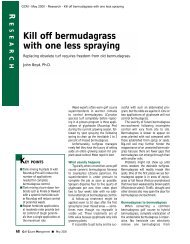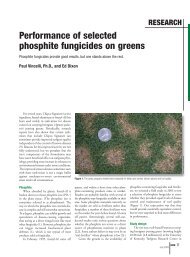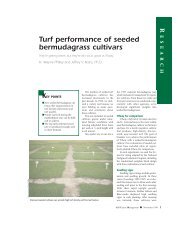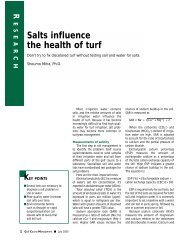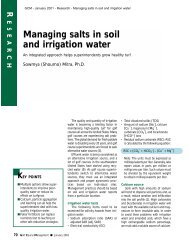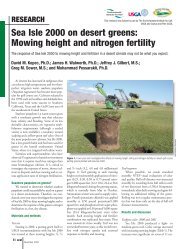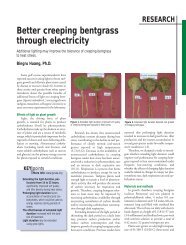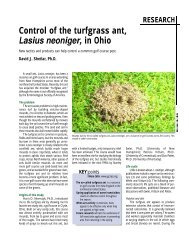Fans and syringing for cooling creeping bentgrass putting ... - GCSAA
Fans and syringing for cooling creeping bentgrass putting ... - GCSAA
Fans and syringing for cooling creeping bentgrass putting ... - GCSAA
You also want an ePaper? Increase the reach of your titles
YUMPU automatically turns print PDFs into web optimized ePapers that Google loves.
<strong>Fans</strong> <strong>and</strong> <strong>syringing</strong> vs. roots353025201510503530252015105035302520151050200020002001■ Fan■ No fan■ Syringe■ No Syringe■ Fan■ No fanTurf quality <strong>and</strong> colorTu rf qu a l i ty <strong>and</strong> co l or were sign i f i c a n t ly affected by fan, s yri n geor the com bi n a ti on of fan <strong>and</strong> syri n ge tre a tm ents on five of s evenra ting date s . Using a 1-9 scale,plots were rated <strong>for</strong> color <strong>and</strong> quality,with a color score of 1 assigned to a completely brown plot,<strong>and</strong>a quality score of 1 assigned to a plot with no living turf.Plots withacceptable color or quality received scores of 5. At three ratings(June <strong>and</strong> August 2000 <strong>and</strong> July 2001), the interaction of fans <strong>and</strong><strong>syringing</strong> was significant, because the combination of fans <strong>and</strong><strong>syringing</strong> improved turf color beyond that observed in the fanonly,syringe-only or untreated plots.When the fan-only treatment was significant (July <strong>and</strong> August2001), turf quality was improved when a fan was used. For example,the average turf quality rating on July 17, 2001, was 6.0 <strong>for</strong>plots with fans <strong>and</strong> 5.2 <strong>for</strong> those without. On Aug. 1, 2001, turfquality in plots with fans averaged 6.0, turf quality in plots withoutfans averaged 4.7. Fan or <strong>syringing</strong> treatments negatively affectedturf color or quality only once, on Aug. 25,2000, when plots receivingonly the syringe treatment had a lower color score than thosenot receiving syringe sprays.Conclusions• Both the fan <strong>and</strong> syri n ge tre a tm ents coo l ed the soil tem pera tu re( m e a su red at a depth of 1 ⁄2 i n ch) of c reeping ben t grass put ti n ggreens du ring the two ye a rs of this stu dy.• The combined treatment of fans + <strong>syringing</strong> was most effective.The fan treatment alone lowered soil temperature, but not asmuch as fans <strong>and</strong> <strong>syringing</strong> combined.• The <strong>cooling</strong> effect of the fan treatment often lasted after the fanshad stopped running. This residual effect typically lasted aboutfour hours.• When air temperatures were lower than 90 F, the treatmenteffects were less pronounced.• Reduced soil temperature did not produce a significant increasein <strong>creeping</strong> <strong>bentgrass</strong> root length.■AcknowledgmentsThanks to the Tem pest Tech n o l ogy Corp. <strong>for</strong> loaning the fans <strong>and</strong> to theAlabama Tu rfgrass Re s e a rch Fo u n d a ti on <strong>for</strong> su pporting this re s e a rch .353025201510502001■ Syringe■ No SyringeReferences1. DiPaola, J. 1984. Syringing effects on the canopy temperatures of <strong>bentgrass</strong>greens. Agronomy Journal 76:951-953.2. Huang, B.,<strong>and</strong> H. Gao. 2000. Growth <strong>and</strong> car bohydrate metabolism o f <strong>creeping</strong><strong>bentgrass</strong> cultivars in response to increasing temperatures. Crop Science40:1115-1120.3. Va r ga s , J. M . ,J r. 1 9 9 4 . Ma n a gem ent of tu rfgrass diseases. Lewis Pu bl i s h ers , Boc aRa ton ,F l a .4. Xu,Q., <strong>and</strong> B. Huang. 2000a. Growth <strong>and</strong> physiological responses of <strong>creeping</strong><strong>bentgrass</strong> to changes in air <strong>and</strong> soil temperatures. Crop Science 40:1363-1368.5. Xu,Q.,<strong>and</strong> B. Huang. 2000b. Effects of differential air <strong>and</strong> soil temperature oncarbohydrate metabolism in <strong>creeping</strong> <strong>bentgrass</strong>. Crop Science 40:1368-1374.Neither fans nor <strong>syringing</strong> significantly affected root-length density in 2000 or 2001.In 2001, root-length density actually decreased throughout the sampling period.Elizabeth Guertal, Ph.D. (e-mail: eguertal@acesag.auburn.edu), is Alumni AssociateProfessor, <strong>and</strong> Dave Han, Ph.D., is an assistant professor <strong>and</strong> Extension specialist,inthe department of agronomy <strong>and</strong> soils at Auburn University, Auburn, Ala.GCM July 2002


